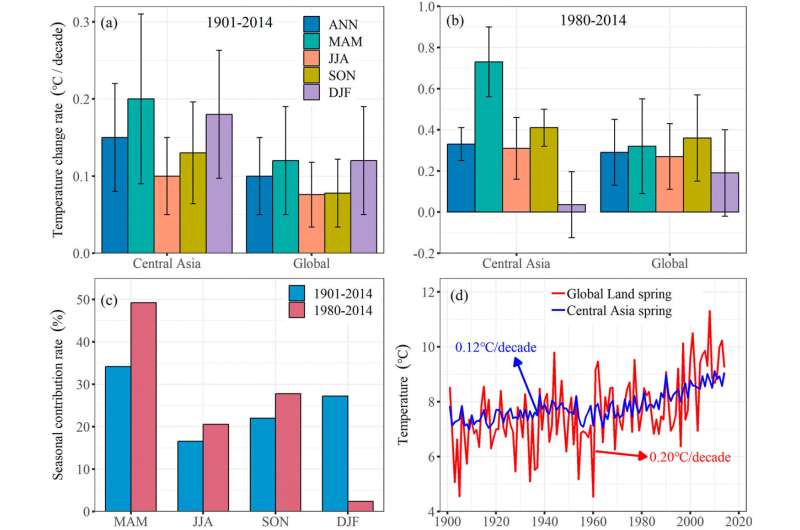This article has been reviewed according to Science X's editorial process and policies. Editors have highlighted the following attributes while ensuring the content's credibility:
fact-checked
peer-reviewed publication
trusted source
proofread
Study reveals that decreased cloud cover dominated rapid spring temperature rise in Central Asia

Central Asia has experienced a faster temperature rise than the global land over the past decades, which has brought unprecedented challenges to the survival and flourishing of life. The role of the drivers and their associated underlying mechanisms have been poorly explored.
A research team led by Prof. Yuan Xiuliang from the Xinjiang Institute of Ecology and Geography of the Chinese Academy of Sciences investigated temperature changes in Central Asia over the past 35 years (1980–2014) and evaluated the contributions of different factors to Central Asia's temperature rise. The findings were published in Geophysical Research Letters.
The precipitation, cloud cover, soil moisture, and solar radiation were considered as potential influencing factors, which were acquired from multi-source data, such as Climatic Research Unit (CRU) datasets, Global Climate Model (GCM) projections from the Coupled Model Intercomparison Project phase 6 (CMIP6), the Global Land Evaporation Amsterdam Model (GLEAM), as well as the fifth generation of the European Center for Medium-Range Weather Forecasts atmospheric reanalysis dataset (ERA5).
The researchers adopted CRU and CMIP6 temperature datasets to study temperature changes in Central Asia from 1980 to 2014 and evaluated the contributions of different factors to the Central Asia temperature. They attempted to identify the factors responsible for accelerating the warming trend in Central Asia and explain why the spring warming rate is faster than that of the global land.
A faster warming trend in Central Asia was confirmed compared to the global land over the period 1980–2014, with values of 0.33°C/decade vs. 0.29°C/decade. This result was consistent, even when the study period was extended between 1901 and 2014 based on the CRU reanalysis, with values of 0.15°C/decade vs. 0.10°C/decade. The GCM simulations under both medium-emission (SSP2–4.5) and high-emission (SSP5–8.5) scenarios indicated that Central Asia will likely experience an accelerated warming trend in the future with the trend expected to continue until the end of the 21st century.
In addition, the researchers found that spring persisted as the season with the highest warming in Central Asia from 1980 to 2014, the warming rate (0.73°C/decade) is higher than the other seasons, nearly 3.5 times greater than the past century. Also, they found that spring warming contributed the most to the annual mean temperature at 49.23%. These results showed that spring warming has dominated the overall Central Asia temperature rise from 1980 to 2014.
The spring temperature was significantly correlated to the decrease of cloud cover (CLD), while other variables had a weak relationship with spring temperature. The CLD was the main driver of spring warming in Central Asia, leading to the surface receiving more solar radiation, consequently heating the surface air temperature, and contributing almost 40.79% to the spring warming. The strengthening of sea level pressure states resulted in continuous subsidence of vertical motion over Central Asia, which was unfavorable for cloud formation.
More information: Gongxin Wang et al, The Decreased Cloud Cover Dominated the Rapid Spring Temperature Rise in Arid Central Asia Over the Period 1980–2014, Geophysical Research Letters (2024). DOI: 10.1029/2023GL107523
Journal information: Geophysical Research Letters
Provided by Chinese Academy of Sciences




















